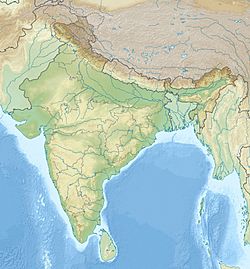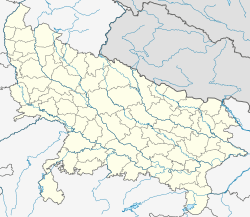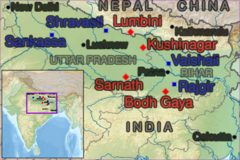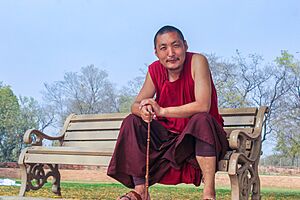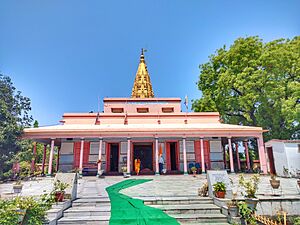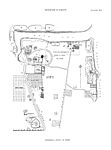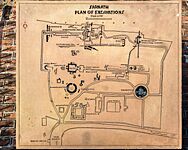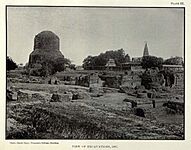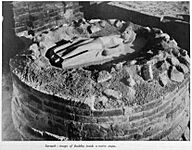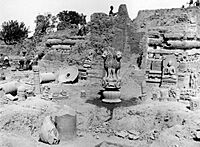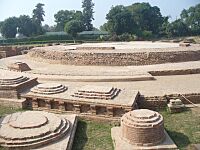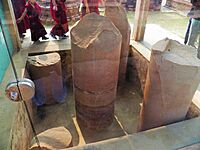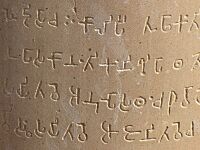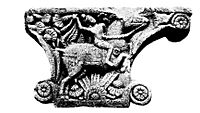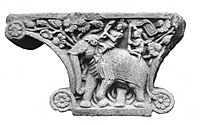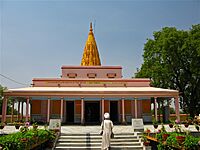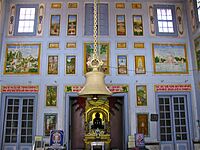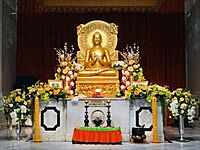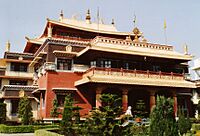Sarnath facts for kids
Quick facts for kids
Sarnath
|
|
|---|---|
|
Historical City
|
|
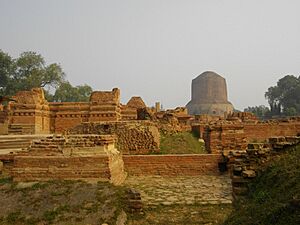
View of Sarnath, looking from the ruins of the ancient Mulagandha Kuty Vihara towards the Dhamek Stupa
|
|
| Nickname(s):
Isipatana
|
|
| Country | |
| State | Uttar Pradesh |
| District | Varanasi |
| Languages | |
| • Local | Bhojpuri |
| Time zone | UTC+5:30 |
|
Basic terms |
|
|
People |
|
|
Schools |
|
|
Practices |
|
|
study Dharma |
|
Sarnath is a very important historical place in India. It is located about 10 kilometers (6 miles) northeast of Varanasi in Uttar Pradesh. Sarnath is famous because it is where Gautama Buddha gave his very first teaching after becoming enlightened.
This happened around 528 BCE when the Buddha was 35 years old. He taught his first sermon, called the Dhammacakkappavattana Sutta, right here. Sarnath is also where the first group of Buddhist followers, called the sangha, began. This happened when the Buddha's first five students became enlightened.
The Buddha himself said that Sarnath is one of the four most important places for his followers to visit. The other three places are Lumbini (where he was born), Bodh Gaya (where he became enlightened), and Kushinagar (where he passed away).
Contents
What Does the Name Sarnath Mean?
The name Sarnath comes from a Sanskrit word, Sāranganātha. This means "Lord of the Deer." This name comes from an old Buddhist story. In the story, the Bodhisattva (a future Buddha) was a deer. He offered his own life to a king instead of a doe the king wanted to hunt.
The king was so touched by this act that he made the area a safe place for deer. This area was called a "deer park," or Mriga-dāva in Sanskrit.
Another old name for Sarnath is Isipatana in the Pali language. This name means "the place where holy men descended." It refers to the many wise and enlightened people who visited or lived here.
A Look at Sarnath's Past
How Buddhism Grew in Sarnath
Buddhism became very strong in Sarnath a long time ago, between 600 and 200 BCE. This was partly because kings and rich traders from nearby Varanasi supported it. By the 3rd century CE, Sarnath was a major center for Buddhist teachings, art, and buildings.
Later, other forms of Buddhism, like Vajrayana, were also practiced here. Even statues of Hindu gods like Shiva and Brahma have been found. There was also a Jain temple very close to the Dhamek Stupa.
Buddhism continued to grow during the Gupta Empire (4th to 6th centuries). A Chinese Buddhist monk named Faxian visited Sarnath around 400-411 CE. He wrote about seeing four big towers and two monasteries where monks lived.
Sarnath in the Middle Ages
Buddhism's influence kept growing from the 6th to 8th centuries. Another Chinese monk, Xuanzang, visited Sarnath around 640 CE. He saw hundreds of small shrines and many monks studying there. Xuanzang also wrote about a famous pillar built by Ashoka. This pillar marked the spot where the Buddha started "the wheel of the law" (his first teaching).
During the Pala Empire (8th–11th centuries), rulers built new large monasteries and supported existing ones like Sarnath. Buddhist pilgrims and monks from all over Asia came to Sarnath to meditate and study. The Palas were the last major Buddhist rulers in India.
Later, the Gahadavala dynasty took over. Even though they were Hindu, they were kind to Buddhists. Records found at Sarnath show that some monasteries received support from these kings. For example, Queen Kumaradevi, a queen from the mid-12th century, helped build or fix living spaces for monks.
Why Sarnath Was Destroyed
By the end of the 12th century, many important Buddhist centers in India, including Sarnath, were still active. However, Buddhism was generally becoming less common in other parts of India.
In the late 12th century, armies from outside India invaded northern India. These invasions caused a lot of damage and looting. One important event was the military campaign led by Muhammad of Ghor and his commander, Qutb ud-Din Aibak. In 1194 CE, their army attacked Varanasi and Sarnath.
The king of that time, Rai Jai Chand, was killed. Almost everything valuable in Varanasi and Sarnath was destroyed or stolen. It is said that Qutbuddin Aibek took away a huge amount of treasure. Another commander, Muhammad Bakhtiyar Khalji, completed the destruction of other major Buddhist centers. Many Buddhists who survived fled to other countries like Nepal and Tibet. By the end of the 12th century, Buddhism had mostly disappeared from India.
How Sarnath Was Found Again
After the destruction, very few Buddhists remained in India. However, Sarnath continued to be a pilgrimage site for Jains. A 17th-century Jain book describes a Jain temple near a famous Buddhist site called dharmeksā, which clearly refers to the Dhamek Stupa.
In the late 1700s, more Europeans started visiting India. In 1778, William Hodges, a British painter, visited Sarnath. He described the Dhamek Stupa, though he thought it was a ruined Hindu temple.
In 1794, Jonathan Duncan found a special green marble box containing bones and pearls inside a brick stupa. Sadly, the bones and pearls were thrown into the Ganges river, and the box disappeared. The bricks from this stupa were used to build a market in Varanasi.
Early Digs and Discoveries
In the early 1800s, more people explored Sarnath. Francis Buchanan-Hamilton drew a simple map of the site around 1813. Colin Mackenzie was the first to explore the ruins in a more organized way in 1815. Many amateur archaeologists dug at Sarnath, taking away old items.
In 1835–1836, a young British engineer named Alexander Cunningham started the first careful archaeological digs. He had studied the writings of the Chinese monks Faxian and Xuanzang. Cunningham found many statues and the sandstone box that Duncan had reported. He sent these items to a museum in Kolkata. By 1836, Cunningham had confirmed that Sarnath was indeed the place of the Buddha's first sermon. He later became the first Director-General of the Archaeological Survey of India.
More digging happened in the mid-1800s. Sadly, Sarnath also suffered more damage. Many statues, bricks, and stones were taken from the site to build bridges and even a railway.
Restoring Sarnath in the 20th Century
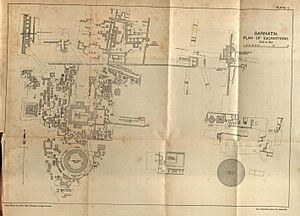
In 1904-1905, F. O. Oertel led a big excavation project. His team focused on important areas like the Dhamek Stupa and the Ashokan pillar. In March 1905, they found parts of the pillar, its famous Lion Capital of Ashoka, and pieces of a large stone wheel. These items, dating back to around 241-233 BCE, are the oldest and most important discoveries at Sarnath.
Sarnath Today: Ancient Ruins to Explore
Sarnath has been carefully studied and restored since the late 1700s. Because of this, it has become an important pilgrimage site again for both Buddhists and Jains. In 1998, Sarnath was suggested to be a World Heritage Site by UNESCO.
Here are some of the most important places to see at Sarnath:
- The Dhamek Stupa: This is a very impressive structure, about 39 meters (128 feet) high and 28 meters (92 feet) wide.
- The Dharmarajika Stupa: This is one of the few very old stupas from before Ashoka's time. Only its foundations remain today.
- The Ashokan pillar: This pillar was broken during invasions in the 12th century, but many pieces are still there. The pillar was topped by the famous Lion Capital of Ashoka. This lion capital and a stone wheel now represent modern India. They are on the emblem of the Supreme Court of India and the flag of India.
- The ruins of the ancient Mulagandha Kuty Vihara: This marks the spot where the Buddha spent his first rainy season. A famous 5th-century stone sculpture of the Buddha Preaching his First Sermon was found nearby.
- The Dharma Chakra Jina Vihar: This was a huge monastery and living area for monks. It was likely built or fixed in the mid-12th century by Queen Kumaradevi.
- The Chaukhandi Stupa: This stupa marks the place where the Buddha met his first five students. It has an octagonal brick tower on top, which was added in 1588 CE by Akbar to honor his father, Humayun.
- The Sarnath Archeological Museum: This museum houses the famous Lion Capital of Ashoka, which survived a 45-foot fall! It also has the original 5th-century sculpture of Buddha Preaching his First Sermon and the Queen Kumaradevi inscription.
Modern Places of Worship
Besides the ancient ruins, Sarnath also has many newer temples and places of worship:
- The modern Mulagandha Kuty Vihara: This Buddhist temple was built by the Maha Bodhi Society and opened in 1931. It has a beautiful golden copy of the Buddha Preaching his First Sermon sculpture. Its walls are covered with paintings by a Japanese artist, showing important moments from the Buddha's life.
- A tall standing Buddha statue: This statue is 24.3 meters (80 feet) high and was inspired by the Buddhas of Bamiyan. It is located at the Thai temple and monastery in Sarnath.
- Many countries with large Buddhist populations, like Cambodia, Japan, and Thailand, have built their own temples and monasteries in Sarnath. This allows visitors to see different styles of Buddhist architecture and learn about various Buddhist cultures.
- A bodhi tree: This tree was planted by Anagarika Dharmapala and grew from a cutting of the original tree at Bodh Gaya where the Buddha became enlightened.
Sarnath as a Jain Pilgrimage Site
Singhpur, a village near Sarnath, is believed to be the birthplace of Shreyansanatha. He was the 11th tirthankara (a great spiritual teacher) of Jainism. Many important life events of Shreyansanatha happened here.
Sarnath has been a significant pilgrimage site for Jains for hundreds of years. The current Sarnath Jain Tirth (also called Shri Digamber Jain Temple) was built in 1824. It is very close to the Dhamek Stupa and is dedicated to Shreyansanatha. The main statue inside is a blue-colored statue of Shreyansanatha, about 75 cm (30 inches) tall, sitting in the lotus position.
Other Things to See in Sarnath
Besides the religious sites, Sarnath also has other attractions for visitors:
- The Sarnath Deer Park and Fish Canal.
- The Sarnath Turtle Breeding and Rehabilitation Centre.
| Year | International | Domestic | Total |
|---|---|---|---|
| 2013 | 362,113 | 838,566 | 1,200,679 |
| 2014 | 374,268 | 899,457 | 1,273,725 |
| 2015 | 388,102 | 924,552 | 1,312,654 |
| 2016 | 409,242 | 957,320 | 1,366,562 |
| 2017 | 430,682 | 1,024,589 | 1,455,271 |
| 2018 | 435,752 | 1,070,035 | 1,505,787 |
| 2019 | 336,136 | 1,132,615 | 1,468,751 |
Sarnath in Books
Sarnath has appeared in several famous books:
- In 1832, poet Letitia Elizabeth Landon wrote a poem called Sarnat, a Boodh Monument. She talked about the different religions of the world and how Buddhists were forced to leave India.
- Sarnath is one of the places in Rudyard Kipling's 1901 novel Kim. A character named Teshoo Lama stays at the "Temple of the Tirthankhers" in Sarnath.
- The fictional city of Sarnath is mentioned in two short stories by H. P. Lovecraft: "The Nameless City" (1921) and "The Doom That Came to Sarnath" (1920).
Images for kids
-
Plan of excavations at Sarnath, with sites labelled using Alexander Cunningham's terminology (1835)
-
The Lion Capital of Ashoka, the Buddha Preaching his First Sermon sculpture, and the Ashokan pillar, along with other antiquities as they appeared upon their exhumation at Sarnath on 15 March 1905 (photograph by F. O. Oertel).
-
Brahmi inscription on the main pillar of Ashoka at Sarnath
-
Greco-Persian sculpture of the head of a West Asian foreigner from the Maurya period, Sarnath Museum
-
The Bala Bodhisattva, an important statue for dating Indian art, was discovered at Sarnath. The statue was dedicated in "the year 3 of Kanishka" (circa 129 CE).


